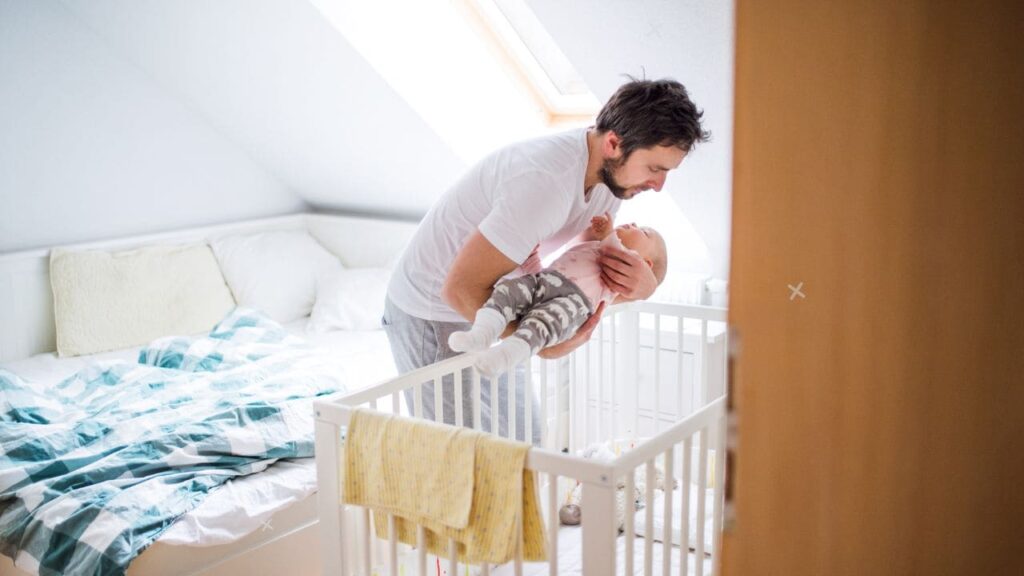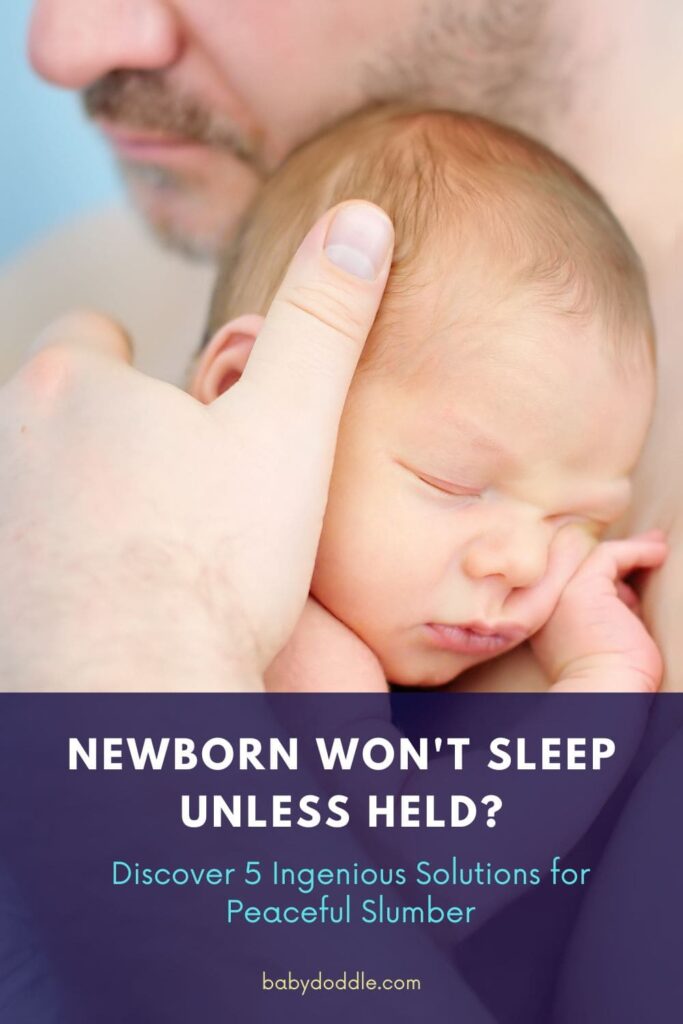The early newborn days are a whirlwind of joy and exhaustion for any new parent. Among the many challenges you’ll face, one of the most common is a baby who simply refuses to sleep unless they’re being held. Whether cradled in your arms or snuggled up against your chest, these little ones seem to have an unquenchable need for constant physical contact, leaving moms and dads feeling drained and desperate for a good night’s rest.
If you’re one of the many parents navigating this sleep-depriving predicament, take heart – you’re not alone. Newborns who won’t sleep unless held are incredibly common, and with the right strategies, you can help your little one transition to peaceful, independent slumber. In this comprehensive guide, we’ll explore the reasons behind this phenomenon and unveil five ingenious solutions to reclaim your family’s rest.

Understanding the “Held Baby” Phenomenon
To effectively address a newborn’s aversion to sleeping alone, it’s important to first understand the underlying causes. This behavior is often rooted in the unique needs and adaptations of a baby’s developing brain and body during the crucial “fourth-trimester” period.
Newborns are biologically primed to seek out the familiar sensations they experienced in the womb – the rhythmic rocking, the steady heartbeat, the warmth of a parent’s embrace. This intense need for physical contact is a survival mechanism, hardwired to help them feel safe, secure, and calm. The Moro reflex, also known as the startle reflex, can also contribute to this sleep struggle, as sudden movements or sounds can cause a baby to jolt awake, desperately seeking the soothing presence of a caregiver.
Additionally, many newborns form powerful sleep associations, where they’ve become accustomed to only drifting off to sleep when being held or rocked. Breaking this habit can be challenging, but with patience and the right techniques, it’s absolutely achievable.
The Science Behind the “Held Baby” Phenomenon
Researchers have delved deeper into the physiological and neurological factors that drive a newborn’s need for constant physical contact. Studies have shown that touch and contact trigger the release of oxytocin, the “love hormone,” which helps babies feel calm and secure. Rocking or swaying a newborn also stimulates the vestibular system, responsible for balance and spatial orientation, providing a soothing sensory experience.
Furthermore, newborns have an underdeveloped prefrontal cortex, the part of the brain that regulates sleep-wake cycles and impulse control. This means they rely heavily on external cues, like the rhythmic motion of being held, to help them transition into and maintain sleep. As their brain matures over the first few months, they’ll gradually develop the ability to self-soothe and fall asleep independently.
Creating a Soothing Sleep Environment
Before diving into specific solutions, it’s crucial to ensure your baby’s sleep environment is optimized for peaceful slumber. Here are some key considerations:
Lighting: Dim, soft lighting in the nursery can help signal to your baby’s body that it’s time to wind down. Avoid bright overhead lights or stimulating screens in the hours before bedtime. You can try using a nightlight with a warm, amber glow or installing dimmers to gradually reduce the brightness as bedtime approaches.
Temperature: The ideal room temperature for a sleeping newborn is typically between 68-72°F (20-22°C). Dress your little one in lightweight, comfortable sleepwear to prevent overheating or chills. Keeping the room a bit on the cooler side can actually help promote better sleep, as babies tend to sleep more soundly in a slightly cooler environment.
White Noise: Incorporating a gentle, consistent sound like a white noise machine or soft lullaby can help muffle startling noises and lull your baby into a deeper, more restful sleep. Look for devices with a variety of soothing sounds, from gentle rainfall to the rhythmic hum of a fan, and experiment to find the one that works best for your little one.
Sleep Associations: Introduce a specific lovey, blanket, or pacifier that your baby can associate with sleep time. This can help them self-soothe when they start to stir. Just be sure to introduce these objects gradually and establish a consistent bedtime routine to strengthen the connection.
With the right sleep environment in place, you’ll be well on your way to helping your newborn transition to peaceful, independent sleep.
| Temperature Range | Recommendation |
|---|---|
| 68°F – 72°F (20°C – 22°C) | Ideal temperature range for newborn sleep |
| Below 68°F (20°C) | May be too cold, increasing risk of overheating |
| Above 72°F (22°C) | May be too warm, making it harder for baby to sleep |
5 Ingenious Solutions for Peaceful Slumber :
Now, let’s dive into the five innovative techniques that can help your little one drift off to sleep without constant holding:
The Gentle Sway
The rhythmic motion of rocking, swaying, or baby-wearing can mimic the comforting sensations your newborn experiences in the womb. Try gently swaying while holding your baby, or invest in a quality baby carrier or swing to provide that soothing movement. As your baby starts to drowse, slowly decrease the intensity of the motion until they’re able to drift off on their own.
For an extra calming effect, you can combine the gentle sway with gentle shushing sounds or lullabies. Many parents find success with a rocking chair or glider, allowing them to rock and sing or hum softly to their little ones. Just be sure to transition your baby to the crib or bassinet before they fall into a deep sleep.
The Calming Embrace
Techniques that recreate the feeling of being held can work wonders for a newborn who won’t sleep unless in your arms. Swaddling your baby snugly in a lightweight, breathable blanket can provide a sense of security and comfort. You can also try skin-to-skin contact, often called “kangaroo care,” by holding your baby against your bare chest. For added coziness, consider using a weighted sleep sack or light blanket to gently envelop your little one.
When swaddling, be sure to follow safe sleep guidelines, allowing room for hip movement and discontinuing the practice once your baby shows signs of trying to roll over. Skin-to-skin contact not only helps soothe your newborn, but it also provides numerous other benefits, like regulating their body temperature and promoting bonding.
The Soothing Sound
Incorporating calming, consistent sounds can help lull your newborn to sleep without the need for physical contact. White noise machines, soothing lullabies, or gentle nature sounds can mask startling noises and create a peaceful, sleep-inducing atmosphere. Experiment to find the audio environment that works best for your baby.
Many parents find success with a combination of white noise and soft, instrumental music. You can also try recording yourself singing or humming a lullaby, as your familiar voice can be incredibly comforting. Keep the volume at a moderate level, as loud or abrupt sounds can actually startle your baby awake.
The Trusted Transition
Gradually weaning your newborn from being held to sleeping independently can be an effective approach. Try the “chair method,” where you sit in a chair next to the crib and slowly move farther away over time. Alternatively, the “fading” technique involves holding or rocking your baby until they’re drowsy, then gently setting them down and leaving the room. Be patient and consistent, as this gradual process can take time.
When using these methods, it’s important to pay attention to your baby’s sleep cues and respond accordingly. If they start to fuss or become agitated, you may need to scoop them up and start the process again. The key is to remain calm and reassuring, providing just the right amount of soothing to help them transition to independent sleep.
The Pacifying Prop
Offering your newborn a pacifier, soft toy, or other age-appropriate sleep aid can provide a comforting substitute for your physical presence. These “transitional objects” can help your baby self-soothe and drift off to sleep without the need for constant holding. Just be sure to introduce them gradually and establish a consistent sleep routine.
Pacifiers, in particular, can be incredibly helpful in providing a soothing, sucking sensation that many newborns find comforting. However, it’s important to use them judiciously, as overreliance on a pacifier can lead to issues like dental problems or speech delays. Rotate between different sleep aids, and consider phasing them out as your baby grows older and more capable of self-soothing.

Adjusting Your Expectations
It’s important to remember that every newborn is unique, and the timeline for achieving independent sleep can vary significantly. Some babies may transition to self-soothing more quickly than others, and that’s perfectly normal. Try not to compare your little one to friends’ or family members’ experiences, as this can lead to frustration and unrealistic expectations. Instead, focus on celebrating small victories and adjusting your approach as needed.
Dealing with Separation Anxiety
As your newborn becomes more aware of their surroundings and develops stronger emotional attachments, they may experience episodes of separation anxiety that contribute to their reluctance to sleep independently. This is a completely normal part of their cognitive and social development, but it can certainly add to the challenge of getting them to drift off to sleep on their own.
To help your little one cope with separation anxiety, try incorporating transitional objects like a special blanket or stuffed animal into their sleep routine. You can also try gradually increasing the time you spend out of their sight, slowly building up their comfort level. Providing plenty of affection and soothing during the day can also help ease their anxiety at bedtime.
Remember, this phase won’t last forever. With consistent, loving support, your newborn will learn to self-soothe and feel secure, even when you’re not physically present.
| Strategy | Description |
|---|---|
| Transitional Objects | – Introduce a special blanket, stuffed animal, or other item<br>- Use it consistently in the sleep routine to help baby self-soothe |
| Gradual Exposure | – Slowly increase the time you spend out of your baby’s sight<br>- This helps build their comfort and confidence with independent sleep |
| Daytime Soothing | – Provide plenty of affection and comfort during the day<br>- This can help ease separation anxiety at bedtime |
Establishing Healthy Sleep Habits
As you help your newborn transition to independent sleep, it’s important to establish healthy habits that will serve them well in the months and years to come. This includes:
- Maintaining a consistent bedtime routine: A predictable series of calming activities, like a warm bath, lullaby, and story time, can cue your baby’s body that it’s time to wind down.
- Introducing appropriate sleep associations: Providing a special stuffed animal, pacifier, or other object that your baby can use to self-soothe can help them fall asleep more easily.
- Avoiding overtiredness: Putting your baby down for sleep when they’re drowsy but still awake can prevent them from becoming overstimulated and make it harder for them to fall asleep.
- Gradually lengthening awake times: As your newborn grows, you can gradually increase the time between naps to help them consolidate their sleep into longer stretches at night.
By setting these healthy foundations early on, you’ll lay the groundwork for better sleep habits that will benefit your whole family.
| Habit | Description |
|---|---|
| Consistent Bedtime Routine | – A series of calming activities (bath, story, lullaby) to cue your baby’s body that it’s time to sleep |
| Appropriate Sleep Associations | – Introduce a special object (stuffed animal, pacifier) to help your baby self-soothe |
| Avoiding Overtiredness | – Put your baby down for sleep when they’re drowsy but still awake to prevent overstimulation |
| Gradually Lengthening Awake Times | – As your newborn grows, increase time between naps to consolidate night sleep |
Handling Nighttime Feedings
When a newborn won’t sleep unless held, nighttime feedings can quickly become a struggle. To help your baby transition back to sleep after eating, consider incorporating some of the techniques mentioned earlier, such as gentle rocking, white noise, or using a pacifier. You can also experiment with adjusting the feeding schedule or trying different feeding positions to find what works best for your little one.
Promoting Healthy Sleep Habits
As you help your newborn learn to sleep independently, it’s important to establish healthy sleep habits that will serve them well as they grow. This includes maintaining a consistent bedtime routine, introducing age-appropriate sleep associations, and avoiding overtiredness. By setting your baby up for success from the start, you’ll lay the groundwork for better sleep in the months and years to come.

Incorporating Movement and Touch
Many newborns find great comfort in rhythmic movement and gentle touch, which can be powerful tools in helping them transition to independent sleep. In addition to the “Gentle Sway” technique, here are some other ways you can incorporate movement and touch:
- Baby wearing: Carrying your newborn in a high-quality wrap or carrier can provide the soothing motion and close contact they crave while leaving your hands free to tend to other tasks.
- Massage: Gently massaging your baby’s back, arms, and legs with calming essential oils can help them relax and prepare for sleep.
- Rocking chair: Rocking back and forth in a comfortable chair, either while holding your baby or with them in a bassinet nearby, can have a hypnotic effect.
- Exercise ball: Gently bouncing on an exercise ball with your newborn cradled in your arms can mimic the sensation of being in the womb.
Experiment with different approaches to find what works best for your little one’s unique needs and preferences.
Developing Patience and Self-Care
Caring for a newborn who won’t sleep unless held can be an immensely challenging experience, both physically and emotionally. It’s crucial that you practice self-compassion and develop a spirit of patience throughout this journey.
Remember that every baby is different, and what works for one may not work for another. Avoid comparing your child’s progress to others, and celebrate even the smallest victories. If you find yourself feeling overwhelmed or frustrated, take a step back and ask for help from your partner, family, or friends.
Prioritize your own self-care as well. Make time for short breaks, even if it’s just a 10-minute power nap or a quick walk around the block. Enlist the support of loved ones to handle household tasks or give you a chance to recharge. Taking care of yourself will not only improve your mental and physical well-being, but it will also enable you to be more present and patient with your little one.
With a combination of tried-and-true techniques, a nurturing environment, and a healthy dose of self-care, you can help your newborn overcome their aversion to independent sleep and enjoy the blissful moments of peaceful slumber together.
When to Transition to the Crib
As your newborn becomes more accustomed to self-soothing and independent sleep, you’ll eventually want to transition them from sleeping in your arms or in a bassinet to their own crib. This can be a delicate process, so take it slowly and watch for your baby’s cues. Some experts recommend making the switch around 4-6 months, but be prepared to adjust the timeline based on your little one’s needs and preferences.
Conclusion
The challenge of a newborn who won’t sleep unless held is a common one, but with the right strategies and a little patience, it can be overcome. By implementing the five ingenious solutions outlined in this guide – the Gentle Sway, the Calming Embrace, the Soothing Sound, the Trusted Transition, and the Pacifying Prop – you can help your little one drift off to sleep peacefully, allowing your family to get the rest you desperately need.
Remember, every baby is unique, so be prepared to experiment and find the approach that works best for your family. With a little creativity, a lot of love, and the right tools, you can navigate this sleep challenge and enjoy the blissful moments of peaceful slumber with your newborn.
FAQ – Newborn Won’t Sleep Unless Held
Why do some newborns refuse to sleep unless they’re being held?
Newborns often have a strong need for the familiar sensations they experienced in the womb, such as rhythmic motion, a steady heartbeat, and physical contact. This intense need for closeness is a survival mechanism that helps them feel safe and secure. Additionally, newborns have an underdeveloped prefrontal cortex, which regulates sleep-wake cycles, causing them to rely heavily on external cues like touch and movement to fall and stay asleep. Breaking these sleep associations can be challenging, but with the right techniques, you can help your baby transition to independent sleep.
What are some effective strategies for getting a newborn to sleep without being held?
The blog post outlines five ingenious solutions to help your newborn sleep independently:
- The Gentle Sway: Using rocking, swaying, or baby-wearing to mimic the comforting motion of being held.
- The Calming Embrace: Techniques like swaddling or skin-to-skin contact that recreate the feeling of being held.
- The Soothing Sound: Incorporating calming white noise, lullabies, or nature sounds to help lull your baby to sleep.
- The Trusted Transition: Gradually weaning your newborn from being held to sleeping independently, using methods like the “chair” or “fading” techniques.
- The Pacifying Prop: Offering age-appropriate sleep aids like pacifiers or loveys to provide a comforting substitute for your physical presence.
How can I create a soothing sleep environment for my newborn?
To optimize your newborn’s sleep environment, consider the following:
- Lighting: Use dim, soft lighting to signal it’s time to wind down.
- Temperature: Maintain a room temperature between 68-72°F (20-22°C) for comfortable, restful sleep.
- White Noise: Incorporate a gentle, consistent sound like a white noise machine or soft lullaby.
- Sleep Associations: Introduce a special lovey, blanket, or pacifier to help your baby self-soothe.
Establishing these calming elements can greatly aid in your newborn’s ability to fall and stay asleep independently.
What should I do if my newborn is experiencing separation anxiety?
Separation anxiety is a normal part of a newborn’s development, and it can contribute to their reluctance to sleep without being held. To help your little one cope:
- Introduce transitional objects like a special blanket or stuffed animal to provide comfort.
- Gradually increase the time you spend out of their sight, slowly building up their confidence.
- Offer plenty of affection and soothing during the day to ease their anxiety at bedtime.
With consistent, loving support, your newborn will learn to self-soothe and feel secure, even when you’re not physically present.
How can I develop healthy sleep habits for my newborn?
Establishing healthy sleep habits early on can benefit your newborn (and you!) in the long run. Some key strategies include:
- Maintaining a consistent bedtime routine of calming activities.
- Introducing appropriate sleep associations like a pacifier or lovey.
- Avoiding overtiredness by putting your baby down when they’re drowsy but awake.
- Gradually lengthening awake times to help consolidate night sleep.
By setting these foundations, you’ll lay the groundwork for better sleep habits that will serve your little one well as they grow.












